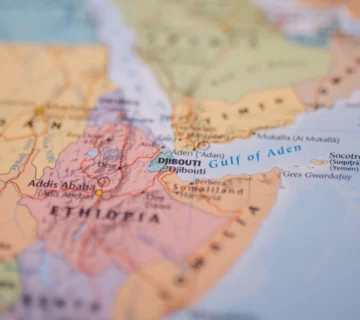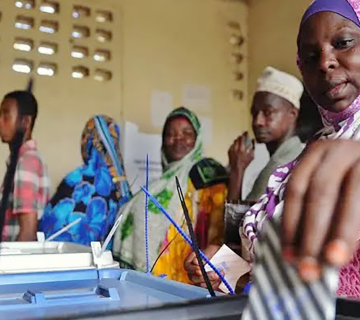The Central African Republic (CAR) is rich in natural resources such as gold and diamonds. Despite gold being the second most-exported product, the country is battling illicit gold mining, which has degraded the environment and become a source of crimes such as human trafficking. Sustainable economic growth in CAR has the potential to provide stability, which has been elusive during the past two decades. To get it back on track, the government and its allies must curb illicit gold mining while also reaffirming their commitment to ensuring that the money generated through mineral resources contributes to much-needed economic growth.
Gold Mining in CAR: A Resource Curse?
A field survey conducted by IPIS in November 2019 revealed a rise in anticipated artisanal and small-scale gold mining (ASGM) production from 1.98 tonnes in 2018 to 5.66 tonnes in 2019. It is also reported that 97.5 per cent of gold output is not legitimately documented and is rather illegally exported out of the country.
According to an Interpol study, some criminal groups involved in illicit gold mining are benefiting from the recent increase in gold prices in CAR. The COVID-19 outbreak triggered a major gold influx into Central Africa with organized cartels capitalizing on the commodity’s price spike and transporting illegal gold to neighbouring nations. As per the Interpol study, cartels are taking advantage of the spike in global gold prices, which reached an all-time high of USD 2,048 per ounce. These criminal networks are accused of amassing gold at lower prices and then exporting it to global financial markets as the commodity’s price doubles. The gold delivered to destination countries makes them more lucrative and economically ‘richer,’ while producing countries, such as CAR, are left with elevated amounts of concealment and heightened trafficking.
Furthermore, illegal mining is frequently associated with financial offences such as tax evasion, corruption, and fraud. These economic crimes damage a country’s fragile economic growth because revenues that could be invested in the country’s development are instead used to fuel illicit operations. The criminal network is heavily involved because of the large earnings connected with these valuable metals and the lack of corresponding punishment. When violent armed organizations and their criminal activities obtain gold mines in CAR, they utilize them to earn wealth and control. The illegal sale of natural resources contributes to significant earnings, and those revenues finance their activities. These funds enrich criminal organizations. As a result, the income generated does not contribute to the total wealth of the country. USAID is an agency that works with policymakers to reduce the negative consequences of ASGM and guarantee that the income created promotes widespread economic growth and development.
The Convergence of Environmental Crimes and Illegal Gold Mining
Illegal gold extraction in CAR has fuelled centralized management over gold and diamond mines controlled by armed organizations involved in forced labour. With this centralized control, ecocide is what has resulted from illegal gold mining in CAR. Illegal extraction has wreaked havoc on the surrounding ecosystem, causing deforestation and habitat loss, as well as water, soil, and air pollution from the discharge of harmful chemicals. It continues to inflict harm on local communities, creating health problems and displacing residents.
As stated by the Global Initiative Against Transnational Organized Crime (GI-TOC), non-state rebel forces earn profits from organized crime and the vast bulk of those profits go to politicians attributed to multinational criminal organizations, which have a strong financial interest in the progression of conflict in the region. Despite acquiring GI-TOC profits, policymaking groups did not constructively employ these profits instead, they continued to address environmental crime as a sustainability concern rather than one that calls into question national safety. Numerous mineral extraction zones are now mainly in the hands of two rebel factions, the Anti-Balaka and the Seleka, who can now financially support their combat even further due largely to the illegal sale of diamonds and gold.
Prospects for Progress
Illegal mining activities in CAR have had long environmental implications, whether from mercury or cyanide poisoning or the loss of flora and fauna. These elements contribute tolong-term impact that are deemed difficult to eradicate in the future. To counter illicit mining in CAR, numerous projects have been initiated. The OECD Due Diligence Guidance for Responsible Supply Chains of Minerals from Conflict-Affected and High-Risk Areas has provided a foundation for new legislation as well as a benchmark in industry norms. It advises corporations on how to avoid contributing to war and the worst human rights violations through their mineral investments. It has also introduced a gold-specific extension.
The International Conference on the Great Lakes Region’s (ICGLR) Strategy against the Illegal Exploitation of Natural Resources (RINR), attempts to establish the ASGM sector and to offer additional “sustainable conflict-free mineral chains” through its Regional Certification Mechanism (RCM) in an attempt to “eliminate financial channels supporting armed groups.” The United States Dodd-Frank Act Section 1502, which pertains to gold originating in the DRC and its surrounding nations, and the EU Regulation on Conflict Minerals, which went into effect on January 1, 2021, essentially mandates businesses listed in the US and EU to use the OECD Due Diligence Guidance on their gold supply chains.
Rather than ignoring the distribution pathways, policymakers should focus on methods to support CAR in protecting legal gold and gold mining techniques. It would contribute to the steady expansion of the economy while also putting a stop to illegal gold mining and distribution networks. Overall, policies must be designed to ensure that officials contribute to preventing illegitimate gold mining and commit to ensuring that the exploitation of mineral resources adds value to CAR’s economy, with appropriate environmental safeguards.
Inayah Issa is a Research Intern at the HORN Institute
Photo: Refined gold in CAR (Photo Credit: Bloomberg)
The contents of this article are copyright of © The HORN Institute 2022. All rights reserved. Any redistribution or reproduction of part or all of the contents in any form and for whatever reason is prohibited. You may use the content of this article for personal reasons, but acknowledge the author and cite the website as sources of the material.



